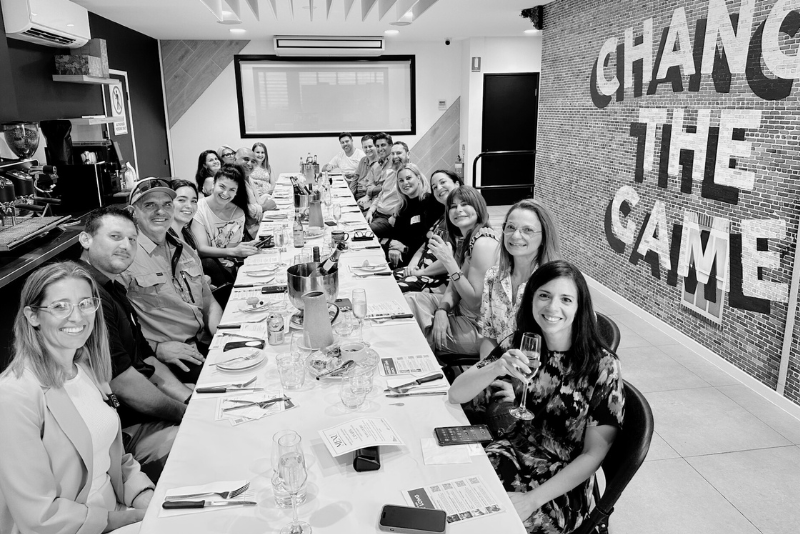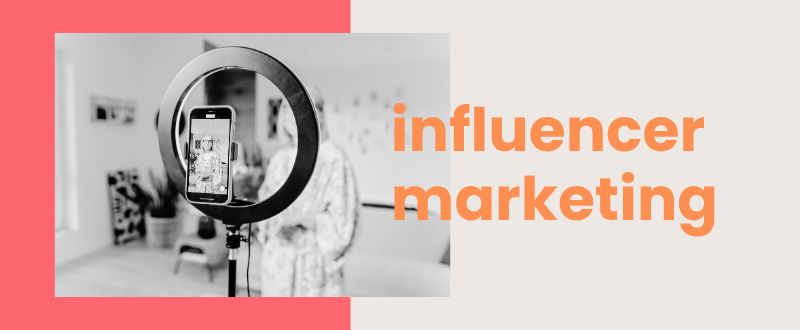On Friday, March 22nd, I was invited to speak at an Industry Long lunch at The Coffee Commune. It was an intimate group of entrepreneurs coming together to discuss the importance of marketing and how to build authenticity through content.
While these business owners and entrepreneurs all came from different industries, they all had one thing in common � the never-ending quest to keep learning and improving.
By constantly looking at ways to improve, they are the ones who will stay ahead of the game, and it was wonderful to have them all there.

Let�s take a deep dive into the discussion�
The four fundamentals of marketing
How long ago did you learn how to drive a car? For me, it was at least twenty years ago. Now, a lot has changed since then, but the fundamental principles of driving a car have not changed at all.
Imagine you had to take a new test every time a new car model came out.
The same goes for marketing.
Since the rise of branding and advertising in the 1950s, the fundamental principles of marketing haven’t really changed at all.
The vehicles have changed.
TV, radio, email, direct mail, events, billboards, SMS, cold calling, referral networks, websites, Google, Facebook, Instagram, podcasts, influencers, YouTube, TikTok – These are all just some of the vehicles.
And in five, ten years, this list will be different.
So don�t get caught up in the constant changes. Instead, focus on the fundamentals that remain consistent.
To find success in marketing, you must be able to confidently answer these four questions:
- How do new customers FIND you?
- How do you CAPTURE these potential customers when they do find you?
- How do you CONVERT these leads into paying customers?
- Once a customer, how do you KEEP them engaged with your brand, so they keep buying from you?
I recently worked with a client who discovered that 95% of their marketing effort was yielding 5% of their results.
By simply asking their audience �how did you find us?� I was able to pinpoint exactly where to focus their marketing strategies.
Remember, not all companies are the same � where one finds customers, another won�t.
The only way to truly make marketing work for you is by finding, capturing, converting, and keeping your target audience.
The first step is to test what works!
The importance of understanding your audience

Just like the elevator pitch, you need to be able to describe your target audience in one or two sentences.
It�s also just as important to understand where your audience is in the customer journey (find, capture, convert or keep).
When it comes to creating compelling content for marketing purposes, communicating with someone who has never seen your brand before is very different to talking to someone who is already engaged with you.
For one, it�s about selling and promoting yourself to them.
For the latter, it�s all about adding value and keeping your brand top-of-mind.
I�m not sure about you but I don�t personally go onto social media to look at ads.
If I�m on YouTube and I get the opportunity to skip an ad, I�ll do it.
Which means brands have to get creative.
They need to stop constantly pushing their product or service onto their audience and find ways to showcase their brand in a whole new way.
Take the time to understand where your audience is A) looking for your product or service, and B) where they are consuming content.
If your business solves a problem, then people are probably searching for it on Google, or perhaps YouTube.
If your business comes mostly from referrals, you might have better luck with Facebook groups.
You don�t have to be on every platform, but you do have to show up on the right ones.
Tim Dive from Workplace Advisory Specialists had the following take away from the event:
�It is important to know where our customers heard from us to have a better understanding of how and where to target them.�
Ask yourself the following question: What emotion is your brand going to make the consumer feel?
Put aside the actual product for a moment and consider the emotion.
Are you selling freedom, safety, happiness, etc?�
Once you understand the emotion your brand delivers, you can plan your content around that feeling rather than around the product or service.�
How to stay adaptable despite emerging technologies

Consistency! Consistency! Consistency!
Did you know that an average business that is consistent in its marketing will outperform a great business that is not?
When I started Content Hive, I understood the value of consistency.
We wrote three SEO-optimised blogs a week that offered good value to our target audience and our website became number one on Google for �Content Marketing Brisbane� in only eight months, outdoing a lot of bigger businesses who had been in the game a lot longer than we had.
And we�ve remained there ever since.
Sure, technologies change, but that doesn�t mean your brand values have to.
�The best way to build a brand is to be consistent.� – Gary Vee.
Consistency means staying on brand.
How do you expect people to remember your business if you keep changing your message or your socials look different every time you post?
For brands to stay adaptable, they must not lose focus of their core values and key messaging.
Through clear strategies and repeatable actions, they need to double down on being consistent in their brand.
Be careful of the shiny object syndrome.
Just because a new technology has emerged, it doesn�t mean you have to forget the fundamentals of marketing.
But remember, you can�t manage what you don�t measure!
The only way to stay ahead is to track your metrics.
Through website ranking, website traffic, conversion rates, retention rates, and customer reviews, you can understand who your audience is and where your marketing efforts are working or not working.
So many small businesses fail because they give up before they see the results.
I could have given up at the three month mark but I stuck with it and it is paying for itself over and over again.
The key is to stay consistent and to keep tracking your metrics.
Step one:
Understand how your audience finds you, buys from you and stays with you.
Step two:
Track the data, test, and adapt accordingly.
April Booij from Fame Event Design resonated with one of the strongest pieces of advice I give to clients, and that�s to �just get started!�
You don�t go to the gym just once and come back with a six pack (if only!).
If you go back in time to a successful brand�s social media posts, you�ll be surprised at how much they�ve refined their posts over the years.
They understood the value of just starting and the power of consistency.
Why authenticity matters

The average consumer is exposed to around 3,000 brand messages a day.
That�s a lot!
And the only way your audience will find you is not by being the shiniest or craziest. It�s about being the most authentic.
The brands that are sticking to being authentic are the ones that are going to come out as the winners.
It might not always seem that way, and it might be tempting to look for quick wins, but it�s consistency and authenticity that will keep you on top.
Social media allows brands to show that they are authentic.
It�s a window that people can peek through to see all facets of your business and the human element behind the brand.
It�s your opportunity to share your wins and challenges and show that you�re real.
People don�t go onto LinkedIn, for example, to follow brands. They go onto LinkedIn to follow people.
Don�t be afraid to be authentic.
What does this mean? It means not shying away when you get a bad Google review. Instead, it�s about showing up and admitting that you made a mistake, and saying you�re sorry, and showing how you�re going to better yourself. In other words, it�s about showing that you�re human.
Authenticity is also about building a personality around your brand.
How can you humanise your brand?
Could you make it funny?
Or be an advocate for something?
Or be educational?
What personality do you want your brand to have and does it align with what you are trying to promote?
What does your brand have in common with your customers?
Yes, you need to stay on brand, but if you don�t get over your fear of being perfect, you�ll never post anything!
If your competitor is selling an average product or service compared to yours, but they post consistently and show authenticity, they�ll outperform you no matter how great your product is.
67% of customers say they will continue buying products if they trust the company behind them! And where does trust come from? Authentic brands!
How to create the perfect content strategy plan

The perfect content plan revolves around your story and then around how you can add value.
By this I mean, what is your compelling narrative?
And then how can you weave this into creating content that adds value to the audience.
What knowledge can you share?
The only way to create a marketing plan is by first understanding who you are, and what makes you unique.
From there, the idea is to leverage your output by creating long-form content and then breaking that down into micro pieces of content.
This might mean a long blog post, video, podcast, and then using that content to repurpose mico snippets (graphics, shorts etc) through social media.
When it comes to content, think BIG first and then go deep and break it down into smaller pieces.
Use the long-form content for SEO strategies and building authority on Google, and then short-form content to help with your consistency.
The power of content is unlimited
- It can build awareness for your brand
- It helps you rank on Google
- It helps build authority and trust
- It allows you to create micro-content to share on social media
- You can reuse it for emailing your database
- It can foster media or speaking opportunities
- It allows you to connect with people
Consistency is key in your content strategy plan, so aim to post at least three times a week on your chosen platforms using the micro-content you broke up from your long-form articles or videos.
Don�t get disheartened if you don�t get bombarded with likes or shares.
Engagement is great, but staying top of mind is really what you�re aiming for.
When creating your perfect content strategy plan, pay attention to the difference between social media advertising and your organic social media pages.
Social media advertising is done through ad campaigns, where you put money behind it and assign a demographic to it. This is great for brand awareness and content that is more �sales� focused.
Organic social media, on the other hand, is all about building your brand while keeping and nurturing customers or potential customers. Use these pages to add value to and build authority over trying to sell, sell, sell!
Using influencers in your marketing strategy

I have engaged a lot of influencers across many campaigns. If you are considering going this route, the key is to always come back to your audience.
It�s not about finding the biggest influencer out there, but rather finding someone who aligns with your brand.
Often, the micro or nano influences will give you a lot more value because they have a more engaged audience. While their followers may be smaller, they are true followers.
When it comes to choosing an influencer, have a look at who your target audience is following and who they trust.
Then make sure that this influencer aligns with your brand�s core values.
Instead of using them to promote your service, why not use them to promote something your brand is passionate about?
It�s not just about selling. It�s a way to prove your authenticity. It gives your brand a little boost in the trust department.
But remember, if you�re checking out the influencer�s page, they�re going to check yours out, too. So, make sure you�re showing consistency and authenticity.
Ideally, if you can become a nano (1,000 – 10,000 followers) or micro influencer (10,000 – 100,000 followers) for your brand – even better!
You can repurpose your brand’s content to achieve this while adding in your own personal flair.
How AI has affected marketing

We are seeing people turning to AI instead of using their own brains and research capabilities to develop an answer, which is concerning.
Is it dumbing down the population? Quite possibly.
However, there is an opportunity for businesses here.
What do I mean?
Brands using AI are at risk of losing their identity because they�ll be relying on a �bot� to generate their content.
It might seem like the easy way out, but when your competitor is using AI too, and they�re also generating very similar content to yours, you�ll quickly lose your individuality and authenticity goes out the door.
The brands that are standing out are the ones who are being original and authentic.
AI is not going anywhere. It�s been around for longer than we realise. ChatGPT might be relatively new, but AI has been implemented in most of the applications and tools you use daily anyway.
You can�t avoid what�s happening. We often have clients ask us: �Why should I use you when I can ask Chat GPT to write my content?�
The answer is simple. If five clients are asking ChatGPT the same questions, they�re all going to put out the same content. And why do you want to be like everyone else?
You need to keep that human touch.
Use AI to improve efficiencies but you still need your finger on the brand�s pulse.
Be authentic.
Don�t be lazy.
AI is a tool in your toolkit, just like everything else. There are thousands of tools. You need to pick which ones to use and how to use them.
Don�t be afraid of AI. Learn how to use it effectively.
You can use AI to come up with topic ideas or use it to refine or structure your work. But you still need to do the bulk of the work yourself and you still need to humanise it.
Technology will change, just like marketing. But the fundamentals are what matters. That will never change. It doesn�t matter what they throw at us next. You�ll be prepared if you know the fundamentals.
If you would like to get clear on your 4 fundamentals of marketing and develop a winning marketing strategy, why not book a call with me today.